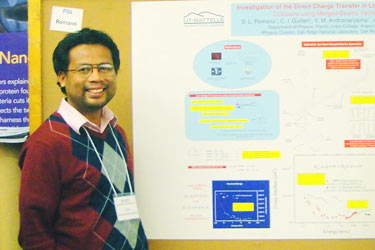Learn More About PUC
PUC Professor Advances Experimental Physics with NSF Grant
By Larry Peña on April 20, 2012
Share this

Vola Andrianarijaona, a professor of physics at Pacific Union College and a winner of a grant from the National Science Foundation, recently returned from a research trip to Tennessee’s Oak Ridge National Laboratory, one of the world’s top experimental physics laboratories. His subject: charge transfer of astroparticles, a largely unexplored area of physics with a broad range of both theoretical and practical applications.
“I chose to focus on these particles because no one else is doing them, because they’re too difficult,” says Andrianarijaona. That’s no idle boast. The particles within the scope of Vola’s research—specifically ion-neutral molecular hydrogen—simply do not exist in Earth’s normal environment, and only occur naturally in the near-vacuum of space and the extreme upper atmosphere.
The resources to simulate the conditions required in Andrianarijaona’s research exist in only a handful of facilities in the world—including Oak Ridge National Laboratory in Tennessee; and the Université catholique de Louvain in Belgium. The physicist has spent much of the last few months gravitating between those facilities, pushing forward on cutting edge experiments. Several of the techniques he is using are so revolutionary that they don’t even have a name, including one apparatus in Belgium that he himself designed and built, and describes as “something like a portable 3-D imaging technique.”
The NSF grant has been vital in providing an important resource as Andrijianarijaona performs his experiments: the assistance of excellent student researchers. PUC physics majors Christian Guillén, Shalyn Romano, and April Vassantachart accompanied the physicist on his most recent trip to Oak Ridge. "Other scientists literally came up to me and said, 'Vola, I didn't expect that your students would be that good,'" he says.
The National Science Foundation is a federal agency created by Congress to promote the progress of scientific discovery, as well as advance national health, welfare and defense. Andrianarijaona’s research into charge transfer has the potential to yield implications in all those areas.
First, as the most basic element in the universe, new insight into the behaviors of hydrogen has the potential to reshape our understandings of fundamental physics. Second, the reactions under observation mimic the conditions of our universe’s earliest moments, meaning that Andrianarijaona’s findings could shed new light on the scientific assumptions as to how those moments occurred.
A little closer to everyday life, his findings may present new insights into the cooling of atomic reactions and the evaluation of current methods of cancer treatment.
The physicist has already presented preliminary results at several international conferences, including last year’s International Conference on Photonic, Electronic and Atomic Collisions. He hopes to publish further findings later this year in several scientific journals.
Latest News
Nursing Students & Faculty Return to Fiji to Serve Their Mana Family
By Ally Romanes on April 16, 2025
PUC’s Department of Music Hosts Unforgettable Festival
By Ally Romanes on April 3, 2025
Rasmussen Art Gallery Hosts Annual Faculty Show
By Ally Romanes on March 24, 2025
Vox Pro Musica & Mosaic Strings Tour Phoenix
By Ally Romanes on March 13, 2025
